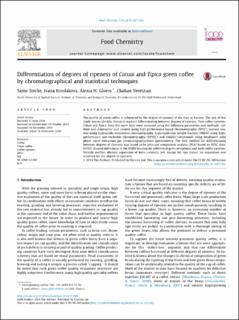Please use this identifier to cite or link to this item:
https://doi.org/10.21256/zhaw-3596Full metadata record
| DC Field | Value | Language |
|---|---|---|
| dc.contributor.author | Smrke, Samo | - |
| dc.contributor.author | Kroslakova, Ivana | - |
| dc.contributor.author | Gloess, Alexia N. | - |
| dc.contributor.author | Yeretzian, Chahan | - |
| dc.date.accessioned | 2018-04-19T15:08:00Z | - |
| dc.date.available | 2018-04-19T15:08:00Z | - |
| dc.date.issued | 2015-05-01 | - |
| dc.identifier.issn | 0308-8146 | de_CH |
| dc.identifier.uri | https://digitalcollection.zhaw.ch/handle/11475/5433 | - |
| dc.description.abstract | The quality of green coffee is influenced by the degree of ripeness of the fruit at harvest. The aim of this study was to identify chemical markers differentiating between degrees of ripeness. Two coffee varieties, Catuai and Tipica, from the same farm were analysed using the following parameters and methods: caffeine and chlorogenic acid content using high-performance liquid chromatography (HPLC), sucrose content using hydrophilic interaction chromatography, high-molecular weight fraction (HMW) using high-performance size-exclusion chromatography (HPSEC) and volatile compounds using headspace solid phase micro extraction gas chromatography/mass spectrometry. The best method for differentiating between degrees of ripeness was found to be principal component analysis (PCA) based on HPLC data. HPSEC showed differences in the HMW fraction for different degrees of ripeness and both coffee varieties. Volatile profiles allowed separation of both varieties; yet, except for ripe Catuai, no separation was achieved for the degree of ripeness. | de_CH |
| dc.language.iso | en | de_CH |
| dc.publisher | Elsevier | de_CH |
| dc.relation.ispartof | Food Chemistry | de_CH |
| dc.rights | https://creativecommons.org/licenses/by-nd/3.0/ | de_CH |
| dc.subject | Green coffee | de_CH |
| dc.subject | Coffee ripeness | de_CH |
| dc.subject.ddc | 663: Getränketechnologie | de_CH |
| dc.title | Differentiation of degrees of ripeness of catuai and tipica green coffee by chromatographical and statistical techniques | de_CH |
| dc.type | Beitrag in wissenschaftlicher Zeitschrift | de_CH |
| dcterms.type | Text | de_CH |
| zhaw.departement | Life Sciences und Facility Management | de_CH |
| zhaw.publisher.place | Amsterdam | de_CH |
| dc.identifier.doi | 10.21256/zhaw-3596 | - |
| dc.identifier.doi | 10.1016/j.foodchem.2014.11.060 | de_CH |
| zhaw.funding.eu | No | de_CH |
| zhaw.originated.zhaw | Yes | de_CH |
| zhaw.pages.end | 642 | de_CH |
| zhaw.pages.start | 637 | de_CH |
| zhaw.publication.status | publishedVersion | de_CH |
| zhaw.volume | 174 | de_CH |
| zhaw.publication.review | Peer review (Publikation) | de_CH |
| Appears in collections: | Publikationen Life Sciences und Facility Management | |
Files in This Item:
| File | Description | Size | Format | |
|---|---|---|---|---|
| 2015_Yeretzian_Differentiation_of_degrees.pdf | 1.08 MB | Adobe PDF |  View/Open |
Show simple item record
Smrke, S., Kroslakova, I., Gloess, A. N., & Yeretzian, C. (2015). Differentiation of degrees of ripeness of catuai and tipica green coffee by chromatographical and statistical techniques. Food Chemistry, 174, 637–642. https://doi.org/10.21256/zhaw-3596
Smrke, S. et al. (2015) ‘Differentiation of degrees of ripeness of catuai and tipica green coffee by chromatographical and statistical techniques’, Food Chemistry, 174, pp. 637–642. Available at: https://doi.org/10.21256/zhaw-3596.
S. Smrke, I. Kroslakova, A. N. Gloess, and C. Yeretzian, “Differentiation of degrees of ripeness of catuai and tipica green coffee by chromatographical and statistical techniques,” Food Chemistry, vol. 174, pp. 637–642, May 2015, doi: 10.21256/zhaw-3596.
SMRKE, Samo, Ivana KROSLAKOVA, Alexia N. GLOESS und Chahan YERETZIAN, 2015. Differentiation of degrees of ripeness of catuai and tipica green coffee by chromatographical and statistical techniques. Food Chemistry. 1 Mai 2015. Bd. 174, S. 637–642. DOI 10.21256/zhaw-3596
Smrke, Samo, Ivana Kroslakova, Alexia N. Gloess, and Chahan Yeretzian. 2015. “Differentiation of Degrees of Ripeness of Catuai and Tipica Green Coffee by Chromatographical and Statistical Techniques.” Food Chemistry 174 (May): 637–42. https://doi.org/10.21256/zhaw-3596.
Smrke, Samo, et al. “Differentiation of Degrees of Ripeness of Catuai and Tipica Green Coffee by Chromatographical and Statistical Techniques.” Food Chemistry, vol. 174, May 2015, pp. 637–42, https://doi.org/10.21256/zhaw-3596.
Items in DSpace are protected by copyright, with all rights reserved, unless otherwise indicated.